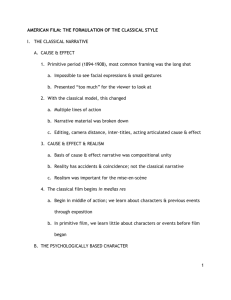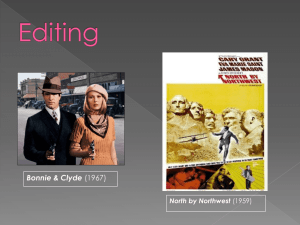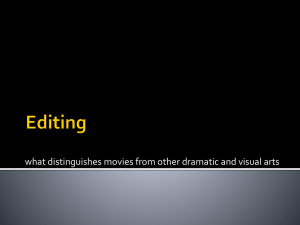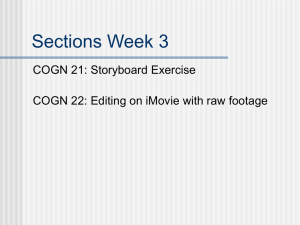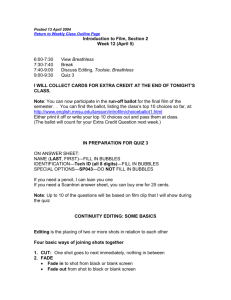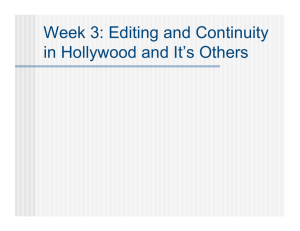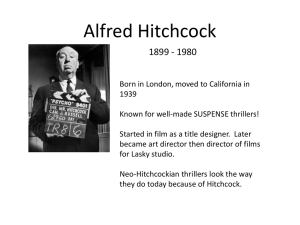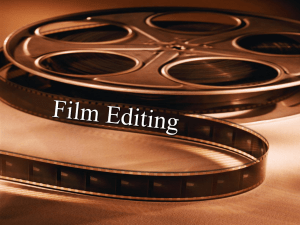Formultation of the Classical Hollywood Style
advertisement
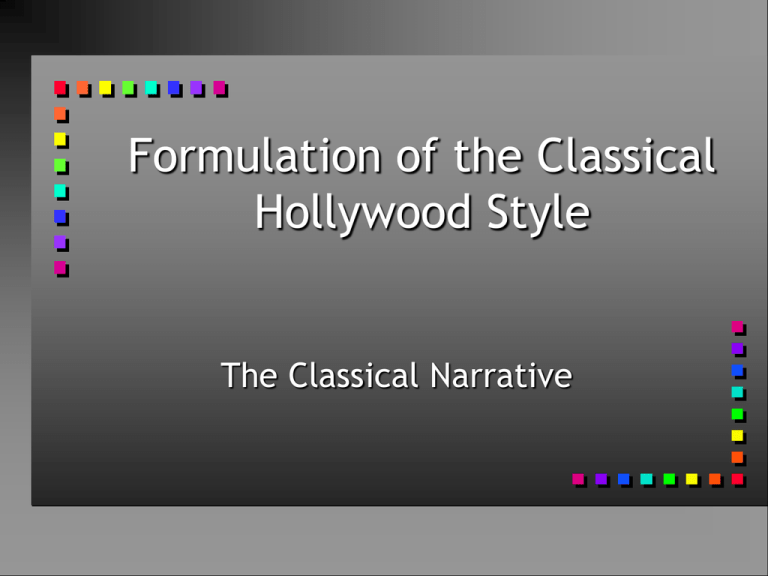
Formulation of the Classical Hollywood Style The Classical Narrative CAUSE & EFFECT Primitive period (1894-1908), most common framing the long shot Impossible to see facial expressions & small gestures Presented “too much” for viewer With classical model, this changed Multiple lines of action Narrative material broken down Editing, camera distance, inter-titles, acting articulated cause & effect CAUSE & EFFECT & REALISM Basis of cause & effect narrative was compositional unity Reality has accidents & coincidence; not the classical narrative Realism important for mise-en-scène The classical film begins in medias res Begin in middle of action; we learn about characters & previous events through exposition In primitive film, we learn little about characters or events before film began THE PSYCHOLOGICALLY BASED CHARACTER Film turned toward literature for characters with multiple traits These character traits were necessary to motivate action Characters have only traits needed for the narrative “Realistic” traits will motivate some later action or event SUBJECTIVITY With increase in length & complexity, additional traits added By 1915, mental subjectivity seen in some films Earlier films had included subjectivity Usually only as basis for entire film or when absolutely necessary With classical film, portions of objective narrations could be subjective OTHER WAYS TO PERSONALIZE CHARACTERS By 1909, most important characters were given names By the mid-1920s, they were also given “tags” Star system also helped to personalize characters CHARACTER GOALS Characters in primitive films reacted to events; in classical films have clear goals Goals met with obstacles CHARACTER & TEMPORAL RELATIONS As films became longer, plots initially covered more story time But generally showed only “high points” Temporal gaps marked with intertitles Films began to cover less time More, briefer, temporal gaps Sought ways to make narration less selfconscious This was solved in several ways: Concentrating on character actions & goals Technical devices marked deviations from chronological order Fades or dissolves instead of superimpositions Also motivated by the narrative DEADLINE important to structuring temporal progression THE FUNCTIONS OF INTER-TITLES EXPOSITORY TITLES Common in primitive cinema Summary expository titles Establishing expository titles In later silent era “LITERARY” inter-title The “ART” inter-title Sometimes used to establish setting Or used non-diegetic images to convey idea DIALOGUE TITLES (came later in primitive cinema, favored over expository titles) Expository titles used at beginning of scenes, dialogue titles within scenes INSERTS: Close-ups of letters, newspaper headlines or articles, photographs, etc. THE “AMERICAN” STYLE OF ACTING 1909-1913, shift in acting style More restrained style; emphasized facial expressions & small gestures Improvements in film stocks, lighting equipment, make-up, etc.; better actors Helped bring about CHC editing style: Close-ups needed to fully utilize this style of acting Breakdown of space required continuity rules UNITY & REDUNDANCY All of these features appeared in the primitive cinema But not used systematically with conventionalized meanings Might use 1 of these features, & build the narrative around it Classical cinema codified devices, used to create unified featurelength films, redundant narratives Formulation of the Classical Hollywood Style The Continuity System THE CONTINUITY SYSTEM & SPACE Editing increased as films became longer & more complicated A potentially disruptive force Required a system to maintain unity After 1907, industry, trade press & “how-to” books promoted continuity as essential for a “well-made” film Referred to both narrative continuity & clearly-articulated space & time Continuity then came to refer specifically to editing guidelines ESTABLISHING SHOTS Originally, films consisted of 1 long take with a fairly distant framing Then, a number of these shots (tableaux) No change in space or time within shots; changes between tableaux Joined by expository inter-titles With multiple shot scenes, these became establishing shots Used to establish mise-en-scène & show most of the action Came at beginning & end of scene; closer shots pointed out details, showed expressions, etc. By late teens, establishing shot functioned as in continuity editing system 1 shot among many, established mise-en-scène Scene itself consisted of a number of closer shots Establishing shot appeared again only if mise-en-scène changed Placement varied; not always at the beginning of the scene ANALYTICAL EDITING IN THE PRIMITIVE ERA Cut-ins used rarely Most often medium shots, from same angle as establishing shot They were used to: Show facial expression Show details not visible in the establishing shot To indicate POV To limit space for special effects Cut-ins avoided if possible; actors moved closer to camera BY THE MID-TEENS Cut-in became much more common No longer had to be motivated by POV, a specific detail of information Could be from any angle Could give a better vantage point Increase in film length & editing made cut-in more acceptable By 1917, cut-in a staple of continuity editing system SCREEN DIRECTION & THE 180° RULE Originally, no editing, therefore no problem Later, 1-D sets & backdrops made it impossible to violate rule Audience conceived of as if it were a theater audience With analytical editing & 3-D sets, the tradition continued Breaks in continuity occurred, but relatively rare They occurred due to: Shots taken out of continuity without script girls The lack of formal guidelines MULTIPLE SPACES CONTIGUOUS SPACES joined by character movement, eyeline match, shot/reverse shot system NON-CONTIGUOUS SPACES Most often articulated using crosscutting Could compress time; important with short films Later, used to expand time; important with longer films SPACE & THE SPECTATOR’S ATTENTION Attention of viewer guided using other elements of film style STAGING IN DEPTH Actors began to move toward the camera After this, actors began to be placed more in depth Helped bring the viewer into a 3-D space SETTINGS & DEPTH Painted backdrops had advantages, but lacked verisimilitude As soon as studios could afford 3-D sets, they did so Late 20s, efforts to eliminate difference between location & studio shots 3-D sets allowed for more extensive analytical editing DEEP FOCUS CINEMATOGRAPHY During most of silent period, efforts to achieve greatest depth of field But only 2 planes were in deep focus (middle ground & background) Deep focus made staging in depth possible However, lighting was needed to draw this attention LIGHTING FOR CLARITY & DEPTH During teens, movement away from even, overall illumination & towards selective lighting An effort to motivate light as coming from diegetic sources Hollywood refined backlighting, creating “rim” lighting FRAMING AS A GUIDE FOR THE SPECTATOR Classical cinema centered important narrative information Camera movement began as a way to center action in frame (reframing) Served other functions also: Tracking & panning to follow actions Panning & tilting to reveal or conceal information With increased planning of shots, camera movement not as necessary STABILITY AFTER 1917 By mid-20s, CHC style reached a high degree of stability Many models to follow Young filmmakers in 1920s had films as their models Informal apprenticeship program Trade papers, instructional manuals, etc. perpetuated style Trade organizations also helped to perpetuate CHC style Adherence to “quality filmmaking” rewarded by audiences & studio heads CONTEMPORARY RECOGNITION OF STANDARDIZATION Standardization regarded as a positive force Early years regarded as a separate era Progress “halted” now that “near perfection” had been attained After this point, changes in CHC style relatively small Minor changes such as increased graphic continuity Assimilation (& “taming”) of other styles Clara Bow, the “It” Girl
